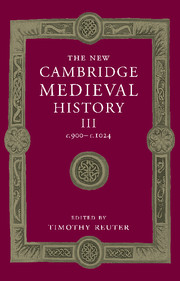Book contents
- Frontmatter
- 1 Introduction: reading the tenth century
- PART I GENERAL THEMES
- 2 Rural economy and country life
- 3 Merchants, markets and towns
- 4 Rulers and government
- 5 The Church
- 6 Monasticism: the first wave of reform
- 7 Intellectual life
- 8 Artists and patrons
- PART II POST-CAROLINGIAN EUROPE
- PART III NON-CAROLINGIAN EUROPE
- Appendix genealogical tables
- List of primary sources
- Bibliography of secondary works arranged by chapter
- Index
- Frontispiece
- Plate section
- Map 2: Archbishoprics and bishoprics in the early eleventh century
- Map 4: Germany
- Map 13: Byzantium in 1025
- References
8 - Artists and patrons
from PART I - GENERAL THEMES
Published online by Cambridge University Press: 28 March 2008
- Frontmatter
- 1 Introduction: reading the tenth century
- PART I GENERAL THEMES
- 2 Rural economy and country life
- 3 Merchants, markets and towns
- 4 Rulers and government
- 5 The Church
- 6 Monasticism: the first wave of reform
- 7 Intellectual life
- 8 Artists and patrons
- PART II POST-CAROLINGIAN EUROPE
- PART III NON-CAROLINGIAN EUROPE
- Appendix genealogical tables
- List of primary sources
- Bibliography of secondary works arranged by chapter
- Index
- Frontispiece
- Plate section
- Map 2: Archbishoprics and bishoprics in the early eleventh century
- Map 4: Germany
- Map 13: Byzantium in 1025
- References
Summary
architecture
The architectural world of the tenth and eleventh centuries is not easy to recover either from what is now to be seen or from the literary sources. First, although we have the literary and archaeological evidence for Ottonian royal palace complexes such as those in Magdeburg or Ravenna, our evidence is predominantly that of churches. And second, as to churches, we see some remarkable experimentation in what has survived, but the literary texts, our only evidence for so much that has been destroyed or rebuilt, tend to present building by abbots and bishops in its traditionalist aspects. Often we have to work from analogies. The church of Romainmôtier in modern Switzerland is probably our best chance of seeing what the second church of Cluny looked like, and Nivelles, where around 1000 a cousin of Otto III called Adelaide was abbess, and where the church has a transept at each end of the nave, is likely to reflect the appearance of Bishop Notker’s (972–1008) cathedral at Liège.
One church of novel character which can still be seen is that of St Martin de Canigou, dating from the earliest years of the eleventh century, and built under the patronage of Count Wifred of Cerdaña. The Pyrenees, as Puig y Cadafalch long ago showed, was an important region for the early development of Romanesque styles. It would be a great mistake to regard this region as out of the way, despite the impression of remoteness the monastery of Canigou now gives, standing on a magnificent spur of the mountain of that name, and commanding staggering views upwards from its cloister.
Keywords
- Type
- Chapter
- Information
- The New Cambridge Medieval History , pp. 212 - 230Publisher: Cambridge University PressPrint publication year: 2000
References
- 1
- Cited by

